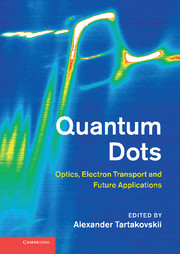Book contents
- Frontmatter
- Contents
- List of contributors
- Preface
- Part I Nanostructure design and structural properties of epitaxially grown quantum dots and nanowires
- Part II Manipulation of individual quantum states in quantum dots using optical techniques
- Part III Optical properties of quantum dots in photonic cavities and plasmon-coupled dots
- Part IV Quantum dot nano-laboratory: magnetic ions and nuclear spins in a dot
- 12 Dynamics and optical control of an individual Mn spin in a quantum dot
- 13 Optical spectroscopy of InAs/GaAs quantum dots doped with a single Mn atom
- 14 Nuclear spin effects in quantum dot optics
- Part V Electron transport in quantum dots fabricated by lithographic techniques from III–V semiconductors and graphene
- Part VI Single dots for future telecommunications applications
- Index
- References
13 - Optical spectroscopy of InAs/GaAs quantum dots doped with a single Mn atom
from Part IV - Quantum dot nano-laboratory: magnetic ions and nuclear spins in a dot
Published online by Cambridge University Press: 05 August 2012
- Frontmatter
- Contents
- List of contributors
- Preface
- Part I Nanostructure design and structural properties of epitaxially grown quantum dots and nanowires
- Part II Manipulation of individual quantum states in quantum dots using optical techniques
- Part III Optical properties of quantum dots in photonic cavities and plasmon-coupled dots
- Part IV Quantum dot nano-laboratory: magnetic ions and nuclear spins in a dot
- 12 Dynamics and optical control of an individual Mn spin in a quantum dot
- 13 Optical spectroscopy of InAs/GaAs quantum dots doped with a single Mn atom
- 14 Nuclear spin effects in quantum dot optics
- Part V Electron transport in quantum dots fabricated by lithographic techniques from III–V semiconductors and graphene
- Part VI Single dots for future telecommunications applications
- Index
- References
Summary
Introduction
Most of the current semiconductor devices rely on intentional, density- and spatially controlled doping with impurities. Dopants of donor and acceptor type enable both to change locally the electronic properties (conductivity, chemical potential, built-in electric field, etc.) and to tune these properties by metallic gates. Using such doping modulation has been shown to be very fruitful in the past two decades to fabricate and investigate semiconductor quantum dots (QDs) in the Coulomb blockade regime where the number of resident charges can be deterministically tuned one by one. In parallel, incorporating magnetic dopants in a semiconductor matrix has long been motivated by the possibility of inducing new properties and developing new functionalities. Observation of ferromagnetism in diluted magnetic semiconductors like Ga1–xMnxAs (with x in the range of a few percent) by the end of the 1990s has more specifically stimulated a lot of work [14]. Even though the Curie temperature of GaMnAs below ˜ 200K is likely to limit its potential use for applications, this compound still behaves like an ideal system to investigate the setup and control of Zener-type ferromagnetism in semiconductors, where the Mn atoms incorporated in the GaAs matrix provide both localized magnetic moments and free carriers. Combining the properties of quantum dots with those induced by magnetic doping is naturally an attractive track to explore, both to tailor new spin-based quantum properties and to investigate the fundamental interactions between carriers and magnetic impurities at the microscopic level. In this perspective, the limiting case of a single magnetic atom in a single quantum dot is obviously the elementary system of highest interest.
- Type
- Chapter
- Information
- Quantum DotsOptics, Electron Transport and Future Applications, pp. 221 - 236Publisher: Cambridge University PressPrint publication year: 2012



